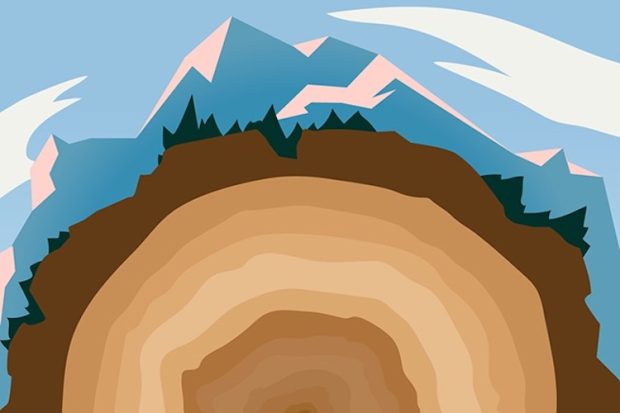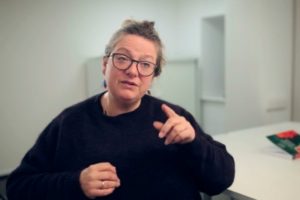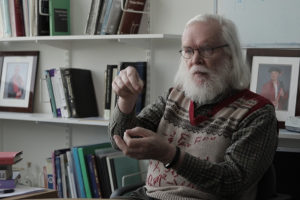The Science of Laughter
Neuroscientist Sophie Scott on contagion effects in laughter, conduct disorder, and the tribes of Namibia
One of the key aspects of understanding how humans and climate and the Earth system interact that has become more and more important over the last 20 or 30 years has been human management (or mismanagement, however, you want to look at it) of the land surface. So it’s about how we interact with vegetation and how we manage the natural landscape and the agricultural landscape for our benefit because that’s what we do as humans. We colonise new places, and we utilise the resources that are available to us. We’ve always done that; that’s what we’re very good at.
What we’re not so good at is knowing when to stop, what the limits of that are, and how to manage the impacts of those things. That’s partly because the dynamics of those things are very complicated. One aspect that has become very apparent over the last 30 or 40 years, or really since the advent of satellite observation, is how important deforestation and forest degradation have become. We all know the figures about how terrible deforestation is and how it’s going on across different parts of the world; it’s happening everywhere.
As an example, close to home, here in the UK, we are one of the least forested areas in Western Europe: about 12-14% of the UK is forest. The vast majority of it is planted coniferous woodland, so essentially commercial plantation forest that was planted mostly since the beginning of the 20th century after WWI. In fact, this is a little bit of historical context here that just shows some of the challenges that we’re facing. The UK isn’t considered to be a forested landscape at all, and it isn’t, but it was, so if we go back 500-600 years to the pre-industrial revolution, not that far, the majority of the landscape, particularly the lowland in the UK would have been covered with dense deciduous woodland with lots of large animals, so there’d have been wild boar, wolves, bears and so on.
That changed dramatically as populations increased and became more mobile and deforested the landscape for timber primarily but for firewood, timber and fuel, and then also to manage the landscape to clear for agriculture: arable and cattle grazing.
Because of all of these pressures on removing forests, it reached its lowest point, so the UK forest was down to a few per cent cover by the end of the 19th century.
So when WWI came along, and the demands for timber were required for building trenches on the front lines of WWI, essentially, the UK ran out of timber for doing that. And the government decided, Look, we can’t allow this to happen; if there’s another war like this, we need to have timber to provide us. So they established the Forestry Commission, whose job was to make sure that the UK had enough timber, and that was by planting conifer forests.
I use this example of almost accidental deforestation and degradation of the woodlands of the UK that happened gradually and then increasingly rapidly as the population increased and urban areas got bigger to the point when it suited us, and we realised there’s not enough woodland: then we decide it’s gone too far, now we ought to do something about it. The woodland in the UK has increased in cover quite a lot to the end of the 20th century: we’re at the highest point for 500 years, but very little of it is the same kind of wood, and that would be recognisable 500 years ago.
Degradation is the gradual encroachment onto forested environments. That might be due to low-level agriculture; it might be due to low-level clearing for woodland and for settlement; it might be due to building roads. If you build roads through forested areas and you increasingly fragment those forests, their value and their richness in terms of species change dramatically because of connectivity. You start building a network of roads, you don’t actually remove a vast amount of forest cover, but if you chop it up into smaller chunks that are cut by roads, then those chunks of forest become more isolated from each other in terms of seed dispersal, in terms of small mammals, birds, larger animals. And that has all sorts of implications for the resilience of those forests, their response to fire, their response to drought, their response to all kinds of other stresses that are coming their way, partly as a result of us, partly as a result of changing climate which is also as a result of us, for all sorts of reasons.
So degradation is the sort of gradual lower-intensity loss of forests. For the distinction between those two things, the first question we want to answer is how much we are losing. Answering that question for deforestation, we do pretty well because it’s a sort of thing again that we can use satellite data to monitor, and we have done over the 20-30 years, and there’s been some really noticeable successes. For example, deforestation in the Amazon was approaching a peak in the 90s. Some of it was legal, was government exploitation of forest resources that were sold off to logging companies; most of it was illegal logging, and it was very hard to track. And if you can’t track it, it’s very hard to prosecute people; it’s very hard to legislate. The whole process requires you to have reliable information about where it’s happening as soon as possible after it happens.
So the Brazilian government actually took a very strong lead on this and developed their own satellite monitoring program, which allowed them to say where illegal logging was happening when it was happening.
There has to be the political will to do something about it but that also requires people to see that yes, it’s happening here, it’s happening on my backyard, somebody’s taking forests that belongs to me there, belongs to us.
And so when that happened, it was a lot easier for the Brazilian government to make that kind of political things stick, and that’s what they did. So, they had a notable success in the late 2000s in reducing deforestation. It’s the one time anywhere, in particularly in tropical regions, where politicians have managed to reduce deforestation. I would say that the more recent picture is perhaps not so optimistic. There’s been an upswing again, but we can use satellite data to monitor deforestation and measure it pretty well. So, if people decide to do something about it, we have the tools to do that.
Degradation is a lot harder to spot because often you don’t see these very obvious patterns that you get with deforestation where whole chunks of forests are disappearing. That is much less obvious when there’s low-level encroachment to forests, when there’s clearance for agriculture, even when there’s selective logging. So if you’re an illegal logging operation, the most stupid thing you could do is go in and just chop down a chunk of forest because it’s obvious. The thing you do is you go in, and you pick the trees that will be most commercially valuable to you. You chop those down, and then you drag them hundreds of meters out of the forest to the nearest roads. In the process, you leave a gap in the canopy, and then you leave these trails through the forest, which are hugely destructive but actually very difficult to see from satellite data.

So degradation is a harder thing to map: it is across a much wider spectrum of forests; it’s not just tropical forests; it’s in temperate forests, and it’s in boreal forests as well. Degradation is known to be a big cause of the loss of forests in general, reducing the quality of those forests for their resilience to climate their value: there’s an ecosystem service to us selfishly but to all other organisms that depend on them. So there’s been a lot of work again in trying to understand how we can map degradation rather than just purely deforestation, and there are UN-led activities in order to try and quantify those things. The UN-REDD+, which is reducing emissions from deforestation and degradation, recognises the fact that it’s not just deforestation; it’s degradation as well.
Addressing those challenges will require political will to do something about it. But what politicians require is hard information that says yes, this is happening, and we all agree that the methods that we’re using to monitor these things are something that we can all sign up to, and that’s not necessarily an easy thing to do. But again, satellite data are helping us to build those pictures that will then enable global institutions to turn to politicians and say, if you want to do something about that, we have the tools to do that.

Neuroscientist Sophie Scott on contagion effects in laughter, conduct disorder, and the tribes of Namibia

Physicist John Ellis on the evidences that the universe is not static, Einstein's equations and what is dark e...

Linguist David Adger on the similarities between all the languages, creation of the new grammatical rules and ...